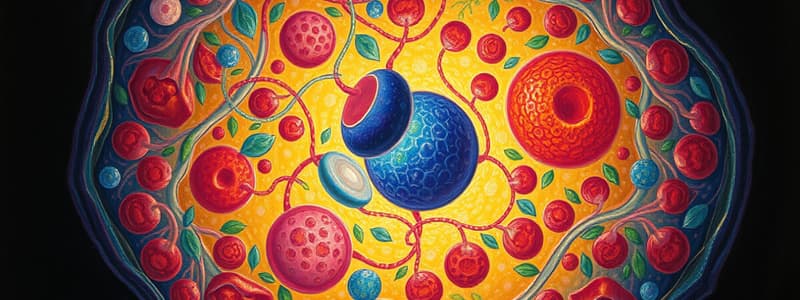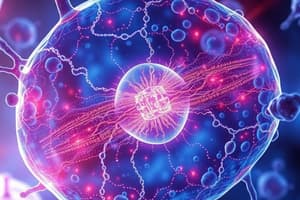Podcast
Questions and Answers
Integral membrane proteins are proteins that are completely embedded within the cell membrane.
Integral membrane proteins are proteins that are completely embedded within the cell membrane.
True (A)
Cytoplasm is located exclusively outside the nucleus.
Cytoplasm is located exclusively outside the nucleus.
False (B)
The Golgi Apparatus modifies and distributes proteins produced by the ribosomes.
The Golgi Apparatus modifies and distributes proteins produced by the ribosomes.
True (A)
Mitochondria are primarily responsible for photosynthesis in plant cells.
Mitochondria are primarily responsible for photosynthesis in plant cells.
During translation, the mRNA codons are matched with tRNA anticodons.
During translation, the mRNA codons are matched with tRNA anticodons.
The plasma membrane is the innermost component of a cell.
The plasma membrane is the innermost component of a cell.
Phospholipids make up approximately 75% of the membrane lipids.
Phospholipids make up approximately 75% of the membrane lipids.
The fluid-mosaic model describes the plasma membrane as rigid and static.
The fluid-mosaic model describes the plasma membrane as rigid and static.
Cell metabolism includes the synthesis of molecules.
Cell metabolism includes the synthesis of molecules.
Cholesterol constitutes more than 50% of the lipid bilayer.
Cholesterol constitutes more than 50% of the lipid bilayer.
Flashcards are hidden until you start studying
Study Notes
Functions of the Cell
- Functions include metabolism, energy use, synthesis of molecules, communication, reproduction, and inheritance.
- Organelles are specialized structures performing specific functions within the cell.
- Cytoplasm is the jelly-like substance that holds organelles and facilitates cellular activities.
- The cell membrane (plasma membrane) forms the cell's outer boundary.
How We See Cells
- Light Microscope: Visualizes general features of cells.
- Electron Microscope: Provides detailed visualization of fine cellular structures.
- Types of Electron Microscopes:
- Transmission Electron Microscope (TEM): For internal structures.
- Scanning Electron Microscope (SEM): For surface details.
- Atomic Force Microscope (AFM): Offers three-dimensional images of surfaces.
Plasma Membrane
- The outermost cell component responsible for structure, attachment, signaling, selective permeability, and acting as a physical barrier.
- Composed of approximately 45-50% lipids (phospholipids and cholesterol), 45-50% proteins, and 4-8% carbohydrates (glycolipids, glycoprotein).
Membrane Lipids
- Phospholipids (~75%): Have a hydrophilic head and hydrophobic tail, forming lipid bilayers.
- Cholesterol (~25%): Maintains membrane fluidity and stability.
- The fluid-mosaic model describes membrane structure as flexible and dynamic.
Membrane Proteins
- Proteins are either integral or peripheral, associated with the cell membrane or organelles, providing various functions.
Movement Through the Plasma Membrane
- Various mechanisms regulate how substances move across the plasma membrane (specific details not provided).
Cytoplasm
- Cytoplasm includes the fluid cytosol, cytoskeleton (support and movement), and cytoplasmic inclusions (non-membrane-bound structures).
- Cytoplasm is the site of numerous chemical reactions essential for maintaining cellular function.
The Nucleus and Cytoplasmic Organelles
- Organelles are specialized for specific functions and may be membrane-bound or not.
- The nucleus is the largest organelle, containing 23 pairs of chromosomes (DNA and proteins), primarily in the form of chromatin.
Ribosomes
- Sites for protein synthesis.
- Ribosomes can be attached to organelles (Rough ER) or free in the cytoplasm, producing different types of proteins.
Endoplasmic Reticulum
- Comprises Rough ER (protein synthesis with ribosomes) and Smooth ER (lipid synthesis, detoxification, and calcium storage).
Golgi Apparatus
- Composed of membrane-bound sacs that modify, package, and distribute proteins and lipids produced in the ER.
Secretory Vesicles
- Membrane-bound structures that transport materials from the Golgi apparatus to the cell surface for exocytosis.
Lysosomes
- Membrane-bound vesicles that contain hydrolytic enzymes for intracellular digestion of macromolecules.
Peroxisomes
- Smaller than lysosomes; detoxify harmful substances and break down fatty acids using enzymes.
Proteasomes
- Large protein complexes that degrade and recycle proteins within the cell.
Mitochondria
- Organelles providing the majority of ATP (energy) for the cell; feature inner (cristae) and outer membranes.
Centrioles
- Located in the centrosome and involved in microtubule formation and mitosis; they are cylindrical structures composed of microtubules.
Cilia and Flagella
- Cilia: Short, hair-like structures for moving materials across cell surfaces (e.g., mucus).
- Flagella: Longer structures used for locomotion (e.g., sperm cells).
Microvilli
- Extensions of the plasma membrane that increase surface area for absorption; found in cells of the intestine and kidneys.
Genes and Gene Expression
- Genes are sequences in DNA that direct the synthesis of specific proteins, integral for heredity.
- Gene expression involves transcription (RNA synthesis) and translation (protein synthesis).
Transcription
- RNA synthesis processes involve RNA polymerase, alternative splicing, and posttranscriptional modifications.
Genetic Code
- mRNA codons (triplets) correspond to specific amino acids during translation; there are 64 codons for 20 amino acids.
Translation
- The process by which mRNA translates into polypeptides occurs at ribosomes, where tRNA brings amino acids as dictated by mRNA.
Cell Cycle
- Consists of interphase and cell division; interphase includes G1, S (DNA replication), G2, and G0 phases.
DNA Replication
- Each strand of DNA serves as a template to create complementary strands during cell division.
Mitosis
- Division of the nucleus into two nuclei, each containing identical DNA. Stages include Prophase, Metaphase, Anaphase, and Telophase.
Apoptosis
- Programmed cell death crucial for maintaining tissue homeostasis; involves gene regulation and cellular fragmentation.
Cellular Aspects of Aging
- Aging hypotheses suggest mechanisms related to cellular clock function and other factors (details not specified).
Studying That Suits You
Use AI to generate personalized quizzes and flashcards to suit your learning preferences.




